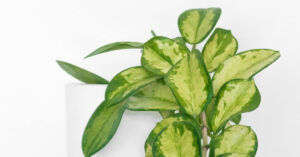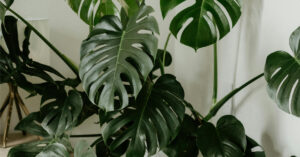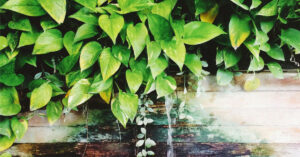Aeschynanthus radicans
Lipstick Plant is a tropical trailing houseplant prized for its glossy leaves and vivid red flowers that emerge from dark tubular buds resembling tubes of lipstick. Native to Southeast Asia, it brings bold color and cascading growth to indoor environments, thriving in bright, warm spaces with the right humidity.
Its showy appearance and hanging growth habit make it perfect for plant shelves, hanging baskets, or high planters. While slightly more demanding than beginner plants, it rewards attentive care with vibrant blooms throughout the growing season.
Light Requirements
Lipstick Plant grows best in bright indirect light. It needs consistent brightness to encourage flowering. A spot near an east- or west-facing window works well, or a few feet from a bright south-facing window.
Avoid direct sun, which can scorch the leaves. In lower light conditions, the plant may continue to grow but will likely stop blooming.
Watering
Water when the top inch of soil feels dry. Lipstick Plant prefers consistently moist but not soggy soil. Overwatering can cause root rot, while underwatering may lead to leaf drop or bud failure.
Reduce watering during fall and winter when growth slows, but avoid letting the soil dry out completely.
Soil Type
Use a well-draining, lightweight potting mix. A peat-based mix combined with perlite or coarse sand helps retain just enough moisture while allowing excess water to escape. Orchid bark can also be added to improve aeration.
Always grow Lipstick Plant in containers with drainage holes to prevent root rot.
Temperature
Lipstick Plant prefers indoor temperatures between 65 and 80°F (18 to 27°C). It does not tolerate cold drafts or temperatures below 60°F (16°C). Avoid placing it near air conditioning vents or cold windows in winter.
Stable warmth and humidity are key to keeping the plant healthy and blooming.
Humidity
This tropical plant enjoys medium to high humidity. If your indoor air is dry, especially in winter, increase humidity using one or more of the following methods:
-
Place a humidifier nearby
-
Set the pot on a pebble tray with water
-
Group with other tropical plants
-
Move it to naturally humid rooms like kitchens or bathrooms
Low humidity can result in dry leaf edges or reduced flowering.
Fertilizing
Feed every 2 to 4 weeks during the growing season (spring through early fall) using a balanced liquid fertilizer diluted to half strength. A formula with equal NPK (such as 10-10-10) works well.
Do not fertilize in winter when the plant is resting. Excess feeding can lead to salt buildup or leaf tip browning.
Growth Habit and Pruning
Lipstick Plant has a trailing or cascading growth habit, making it ideal for hanging baskets or elevated planters. It can grow several feet long over time, creating a dramatic hanging effect.
Prune lightly after flowering to control size and encourage bushier growth. Use clean scissors to trim back leggy or uneven stems. Removing spent flowers may also help redirect energy into new growth.
Flowering Expectations
When grown in optimal conditions, Lipstick Plant produces clusters of tubular red or orange flowers that emerge from deep maroon buds. Flowering is most likely in late spring through early fall and may occur multiple times per year.
To encourage blooms:
-
Provide bright, consistent light
-
Maintain regular watering without overwatering
-
Increase humidity
-
Avoid repotting too often
-
Keep the plant slightly root-bound
A mature plant in the right environment can produce dozens of bright blooms at once.
Repotting
Repot every 2 to 3 years, or when roots begin to circle the bottom of the container. Use fresh, well-draining soil and a pot only slightly larger than the current one. Lipstick Plant blooms more readily when slightly root-bound.
Repot in spring before new growth begins.
Propagation
Lipstick Plant is easy to propagate from stem cuttings.
Steps for propagation:
-
Take a 4- to 6-inch cutting with several leaves
-
Remove lower leaves and root in water or moist potting mix
-
Cover with a plastic dome or place in a humid area
-
Keep in bright indirect light until roots develop (2 to 4 weeks)
-
Transplant to a small pot once roots are well established
Cuttings taken in spring or early summer tend to root faster and more successfully.
Common Problems and Solutions
No flowers
Usually caused by low light or low humidity. Move to a brighter location and increase humidity.
Leaf drop
Can result from sudden temperature changes, dry soil, or drafts. Keep conditions stable and avoid underwatering.
Yellow leaves
Often a sign of overwatering. Let the soil dry more between waterings.
Brown leaf edges
Typically caused by low humidity or salt buildup. Increase humidity and flush the soil occasionally with water.
Pests
Occasionally affected by mealybugs, aphids, or spider mites. Inspect regularly and treat with neem oil or insecticidal soap if needed.
Pet and Child Safety
Lipstick Plant is non-toxic to cats, dogs, and humans. It is considered a safe houseplant for households with pets and children, though it’s always best to discourage chewing on any plant.
Why Lipstick Plant Adds Color and Character to Your Collection
Lipstick Plant is one of the few flowering houseplants that combines colorful blooms with a lush trailing form. Its vibrant flowers and glossy green foliage make it a standout on plant shelves, windowsills, or in hanging displays.
With just a little extra attention to light and humidity, it offers reliable growth and bold seasonal color. Whether you’re looking to expand your collection or introduce flowering plants into your home, Lipstick Plant brings personality and charm to any space.




